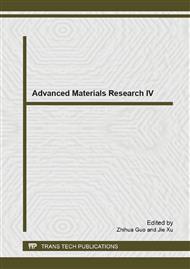[1]
V. Ruiz, C. Blanco, E. Raymundo-Piñero, V. Khomenko, F. Béguin, R. Santamaría, Effects of thermal treatment of activated carbon on the electrochemical behaviour in supercapacitors, Electrochimica Acta 52 (15) (2007) 4969-4973.
DOI: 10.1016/j.electacta.2007.01.071
Google Scholar
[2]
K.H. An, W.S. Kim, Y.S. Park, J. -M. Moon, D.J. Bae, S.C. Lim, Y.S. Lee, Y.H. Lee, Electrochemical Properties of High-Power Supercapacitors Using Single-Walled carbon Nanotube Electrodes Advanced Functional Materials 11 (2001) 387-392.
DOI: 10.1002/1616-3028(200110)11:5<387::aid-adfm387>3.0.co;2-g
Google Scholar
[3]
S.C. Pang, W.H. Khoh, S.F. Chin, Synthesis and Characterization of Magnetite/Carbon Nanocomposite Thin Films for Electrochemical Applications, Journal of Materials Science Technology 27 (2011) 873-878.
DOI: 10.1016/s1005-0302(11)60158-8
Google Scholar
[4]
T. Brousse, D. Bélanger, A Hybrid Fe3O4-MnO2 Capacitor in Mild Aqueous Electrolyte, Electrochemical and Solid-State Letters 6 (11) (2003) A244.
DOI: 10.1149/1.1614451
Google Scholar
[5]
N. -L. Wu, Nanocrystalline oxide sueprcaapcitors, Materials Chemistry and Physics 75 (2002) 6-11.
Google Scholar
[6]
N. -L. Wu, S. -Y. Wang, C. -Y. Han, D. -S. Wu, L. -R. Shiue, Electrochemical capacitor of magnetite in aqueous electrolyte, Journal of Power Sources 113 (2003) 173-178.
DOI: 10.1016/s0378-7753(02)00482-2
Google Scholar
[7]
S.J. Park, Y.H. Kim, Roles of Nanosized Fe3O4 on Supercacitive Properties of Carbon Nanotubes, Current Applied Physics 11 (2011) 462-466.
DOI: 10.1016/j.cap.2010.08.018
Google Scholar
[8]
X. Zhao, C. Johnston, P.S. Grant, A novel hybrid supercapacitor with a carbon nanotube cathode and an iron oxide/carbon nanotube composite anode, Journal of Materials Chemistry 19 (46) (2009) 8755.
DOI: 10.1039/b909779a
Google Scholar
[9]
D. Chen, G. Ji, Y. Ma, J.Y. Lee, J. Lu, Graphene-encapsulated hollow Fe3O4 nanoparticle aggregates as a high-performance anode material for lithium ion batteries, ACS applied materials & interfaces 3 (8) (2011) 3078-3083.
DOI: 10.1021/am200592r
Google Scholar
[10]
C. Masarapu, H.F. Zeng, K.H. Hung, B. Wei, Effect of Temperature on the Capacitance of Carbon Nanotube Supercapacitors, ACS Nano 3 (2009) 2199-2206.
DOI: 10.1021/nn900500n
Google Scholar
[11]
S.W. Zhang, G.Z. Chen, Manganese oxide based materials for supercapacitors, Energy Materials: Materials Science and Engineering for Energy Systems 3 (3) (2008) 186-200.
DOI: 10.1179/174892409x427940
Google Scholar
[12]
W. -C. Fang, J. -H. Huang, L. -C. Chen, Y. -L.O. Su, K. -H. Chen, Effect of temperature annealing on capacitive and structural properties of hydrous ruthenium oxides, Journal of Power Sources 160 (2) (2006) 1506-1510.
DOI: 10.1016/j.jpowsour.2006.03.017
Google Scholar
[13]
C.C. Hu, Y.H. Huang, K.H. Chang, Annealing effects on the physicochemical characteristics of hydrous ruthenium and ruthenium-iridium oxides for electrochemical supercapacitors, Journal of Power Sources 108 (2002) 117-127.
DOI: 10.1016/s0378-7753(02)00011-3
Google Scholar
[14]
E.E. Kalu, T.T. Nwoga, V. Srinivasan, J.W. Weidner, Cyclic voltammetric studies of the effects of time and tmeperature on the capacitance of electrochmeically deposited nickel hydroxide, Journal of Power Sources 92 (2001) 163-167.
DOI: 10.1016/s0378-7753(00)00520-6
Google Scholar
[15]
K. -W. Nam, W. -S. Yoon, K. -B. Kim, X-ray absorption spectroscopy studies of nickel oxide thin film electrodes for supercapacitors, Electrochimica Acta 47 (2002) 3201-3209.
DOI: 10.1016/s0013-4686(02)00240-2
Google Scholar
[16]
J. -K. Chang, Y. -L. Chen, W. -T. Tsai, Effect of heat treatment on material characteristics and pseudo-capacitive properties of manganese oxide prepared by anodic deposition, Journal of Power Sources 135 (1-2) (2004) 344-353.
DOI: 10.1016/j.jpowsour.2004.03.076
Google Scholar
[17]
J. -K. Chang, W. -T. Tsai, Microstructure and Pseudocapacitive Performance of Anodically Deposited Manganese Oxide with Various Heat-Treatments, Journal of The Electrochemical Society 152 (10) (2005) A2063.
DOI: 10.1149/1.2034527
Google Scholar
[18]
M. -T. Lee, J. -K. Chang, Y. -T. Hsieh, W. -T. Tsai, Annealed Mn–Fe binary oxides for supercapacitor applications, Journal of Power Sources 185 (2) (2008) 1550-1556.
DOI: 10.1016/j.jpowsour.2008.09.007
Google Scholar
[19]
W-C. Fang, J-H. Huang, L-C. Chen, Y-L. Su, K-H. Chen, Effect of temperature annealing on capacitive and structural properties of hydrous ruthenium oxides, Journal of Power Sources 160 (2006) 1506-1510.
DOI: 10.1016/j.jpowsour.2006.03.017
Google Scholar
[20]
J. R. Macdonald, E. Barsoukov, Impedance Spectroscopy, Theory Experiment and Applications Canada: John Wiley & Sons, Inc (2005).
Google Scholar
[21]
V. D. Jovic. (2012). Determination of the correct value of Cdl from the impedance results fitted by the commercially available software [Online]. Available: http: /www. gamry. com [access in Jan 2013].
Google Scholar
[22]
P-L Taberna, P. Simon, in: Electrochemical Techniques, edtied by G.Q. Max Lu, Wiley-VCH, Weinheim, Germany (2013).
Google Scholar


